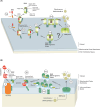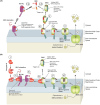The C-terminal sequences of Bcl-2 family proteins mediate interactions that regulate cell death
- PMID: 38985308
- PMCID: PMC11346437
- DOI: 10.1042/BCJ20210352
The C-terminal sequences of Bcl-2 family proteins mediate interactions that regulate cell death
Abstract
Programmed cell death via the both intrinsic and extrinsic pathways is regulated by interactions of the Bcl-2 family protein members that determine whether the cell commits to apoptosis via mitochondrial outer membrane permeabilization (MOMP). Recently the conserved C-terminal sequences (CTSs) that mediate localization of Bcl-2 family proteins to intracellular membranes, have been shown to have additional protein-protein binding functions that contribute to the functions of these proteins in regulating MOMP. Here we review the pivotal role of CTSs in Bcl-2 family interactions including: (1) homotypic interactions between the pro-apoptotic executioner proteins that cause MOMP, (2) heterotypic interactions between pro-apoptotic and anti-apoptotic proteins that prevent MOMP, and (3) heterotypic interactions between the pro-apoptotic executioner proteins and the pro-apoptotic direct activator proteins that promote MOMP.
Keywords: BH3-only proteins; Bax; Bcl-2; apoptosis; protein–protein interactions; transmembrane domain.
© 2024 The Author(s).
Conflict of interest statement
The authors declare that there are no competing interests associated with the manuscript.
Figures




Similar articles
-
Discoveries and controversies in BCL-2 protein-mediated apoptosis.FEBS J. 2016 Jul;283(14):2690-700. doi: 10.1111/febs.13527. Epub 2015 Oct 27. FEBS J. 2016. PMID: 26411300 Review.
-
Examining BCL-2 family function with large unilamellar vesicles.J Vis Exp. 2012 Oct 5;(68):4291. doi: 10.3791/4291. J Vis Exp. 2012. PMID: 23070252 Free PMC article.
-
Apoptosis regulation at the mitochondrial outer membrane.J Cell Biochem. 2014 Apr;115(4):632-40. doi: 10.1002/jcb.24709. J Cell Biochem. 2014. PMID: 24453042 Review.
-
How do BCL-2 proteins induce mitochondrial outer membrane permeabilization?Trends Cell Biol. 2008 Apr;18(4):157-64. doi: 10.1016/j.tcb.2008.01.007. Epub 2008 Mar 7. Trends Cell Biol. 2008. PMID: 18314333 Free PMC article. Review.
-
Many players in BCL-2 family affairs.Trends Biochem Sci. 2014 Mar;39(3):101-11. doi: 10.1016/j.tibs.2013.12.006. Epub 2014 Feb 3. Trends Biochem Sci. 2014. PMID: 24503222 Free PMC article. Review.
Cited by
-
Targeting Mitochondrial Dysfunction in Cerebral Ischemia: Advances in Pharmacological Interventions.Antioxidants (Basel). 2025 Jan 18;14(1):108. doi: 10.3390/antiox14010108. Antioxidants (Basel). 2025. PMID: 39857442 Free PMC article. Review.
-
Bid Protein: A Participant in the Apoptotic Network with Roles in Viral Infections.Int J Mol Sci. 2025 Mar 7;26(6):2385. doi: 10.3390/ijms26062385. Int J Mol Sci. 2025. PMID: 40141030 Free PMC article. Review.
-
The BCL2 family: from apoptosis mechanisms to new advances in targeted therapy.Signal Transduct Target Ther. 2025 Mar 21;10(1):91. doi: 10.1038/s41392-025-02176-0. Signal Transduct Target Ther. 2025. PMID: 40113751 Free PMC article. Review.
-
Structural basis of BAK sequestration by MCL-1 in apoptosis.Mol Cell. 2025 Apr 17;85(8):1606-1623.e10. doi: 10.1016/j.molcel.2025.03.013. Epub 2025 Apr 4. Mol Cell. 2025. PMID: 40187349
References
Publication types
MeSH terms
Substances
LinkOut - more resources
Full Text Sources
Research Materials
Miscellaneous

